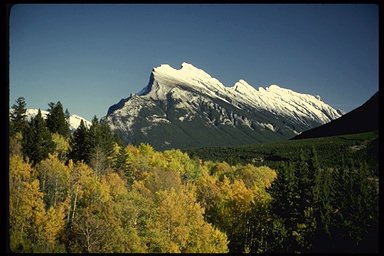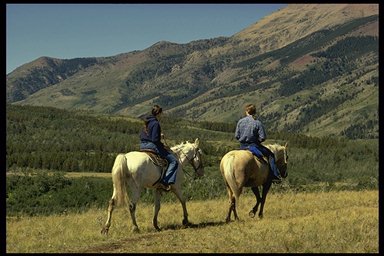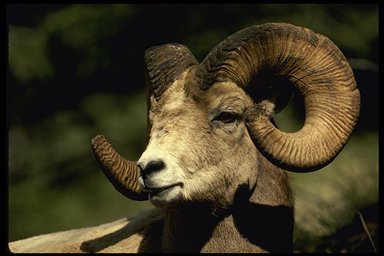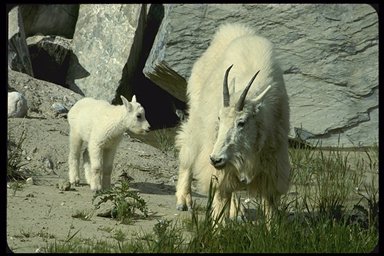
Glistening snow-capped peaks and thundering waterfalls, bugling elk and whistling marmots, lakes of startling turquoise and ice-blue glaciers - this natural region is postcard country. Within this region is some of the most famous and familiar mountain scenery in the world.

This region encompasses a series of parallel ranges including the Rocky Mountains
and the foothills. These are orderly mountains, with wide sweeping valleys separating
the ranges and open pine forests cloaking their shoulders. The sedimentary rocks
making up the mountains of this region, sculpted by glaciers and rushing water, have
resulted in distinctive, angular peaks. Many peaks exceed 3000 metres with Mt.
Robson, at 3954 metres, being the highest.

VEGETATION:
Dramatic climate changes caused by elevation, rainshadow effects and latitude create
a complex, diverse pattern of vegetation ranging from grasslands and alpine meadows
to towering forests of evergreens. But the most dominant vegetation is the sub-alpine
forest. This is a high forest, spreading down valleys below alpine meadows like a black
tide. It can be an open, sunlit easy-to-walk-through forest typified by lodgepole pine or a
dark, dense and damp forest of sharp-pointed Engelmann spruce and alpine fir. Alpine
larch provide brilliant yellow patches of colour each autumn. Montane grasslands cover
large areas along the valley bottomlands.

WILDLIFE:
This region is famous for its easily observed wildlife. In long-established parks such as
Banff and Jasper, the wildlife has learned to tolerate and, in some cases, to exploit
people, making these parks the premier place in North America for mammal-watching.
A drive along the highways traversing the national parks almost guarantees sightings of
moose, elk, mule deer, Rocky Mountain bighorn sheep, mountain goats, black bear or
coyote. The region is also known for its game fish. Many species of trout, including
non-native species such as brook and brown trout, thrive in the region's cold water
rivers and streams alongside native rainbow, cutthroat and Dolly Varden.

STATUS OF NATIONAL PARKS:
Canada's national parks system has its beginnings in this region over 100 years ago with the creation of a 26-square-kilometre national reserve around hot sulphur springs discovered near Banff. Since then, this reserve has grown to an area of 6641 square kilometres and become known as Banff National Park. Yoho (1313 km2) and Waterton Lakes (505 km2) were established by the federal government in 1886 and 1895 respectively; Jasper (10 878 km2) in 1907; and Kootenay (1406 km2) in 1920.
Today, the five national parks protect more than 12 percent of the region's area, providing representation of the geology, vegetation and wildlife of the Rocky Mountains. Waterton Lakes National Park is linked with Montana's Glacier National Park as Waterton-Glacier International Peace Park, and in 1995 these two areas were declared a World Heritage Site based upon the exceptionally rich plant and mammal diversity and outstanding glacial and alpine scenery. Waterton Lakes National Park also forms the core area of the Waterton Biosphere Reserve, one of six biosphere reserves in Canada.
The contiguous block of Banff, Jasper, Kootenay and Yoho national parks, augmented by several provincial parks and wilderness areas on its periphery, is among the largest protected areas in the mountains of North America. These four national parks, along with the provincial parks of Mount Robson, Mount Assiniboine and Hamber were declared a World Heritage Site because of their exceptional geological features and unspoiled beauty.
The sedimentary strata of the mountains - ancient seabeds compressed into rock and thrust into the sky - bear witness to events from a billion years ago to the age of mammals, the most complete sequence of sedimentary rocks found in Canada. The Burgess Shale Formation in Yoho National Park contains a remarkably preserved record of sea life from over 500 million years ago.
Astride the continental divide, the Columbia Icefield feeds rivers leading to three oceans - the Pacific, the Atlantic and the Arctic. The largest known cave system in Canada - Castleguard Cave - extends below the Columbia Icefield. No one yet knows just how far. One of the world's largest known underground rivers drains Medicine Lake, promising still larger cave systems waiting to be discovered. Some of the most famous hot springs in Canada are found here, including the Banff Hot Springs, which was the initial reason for establishing the first national park in Canada.